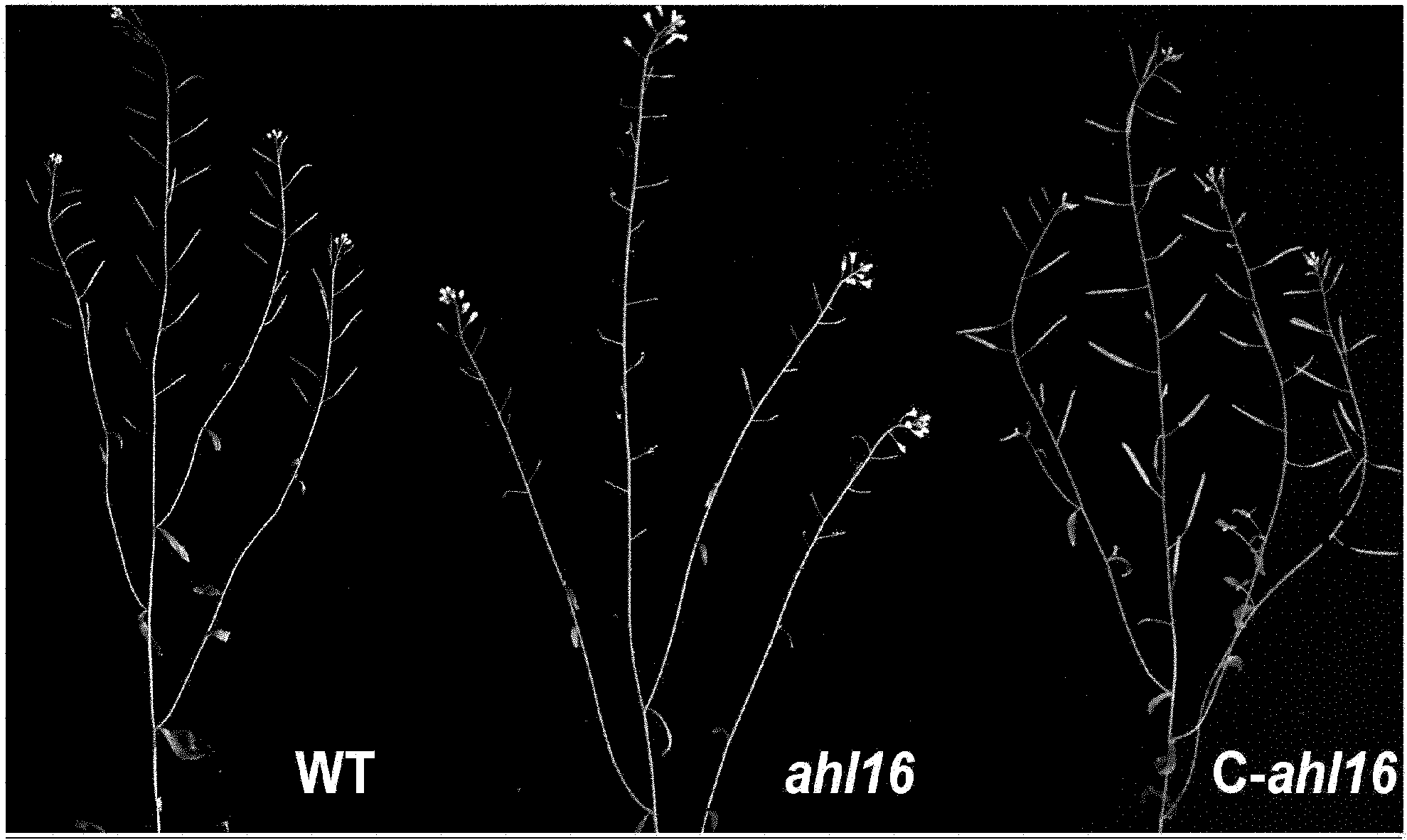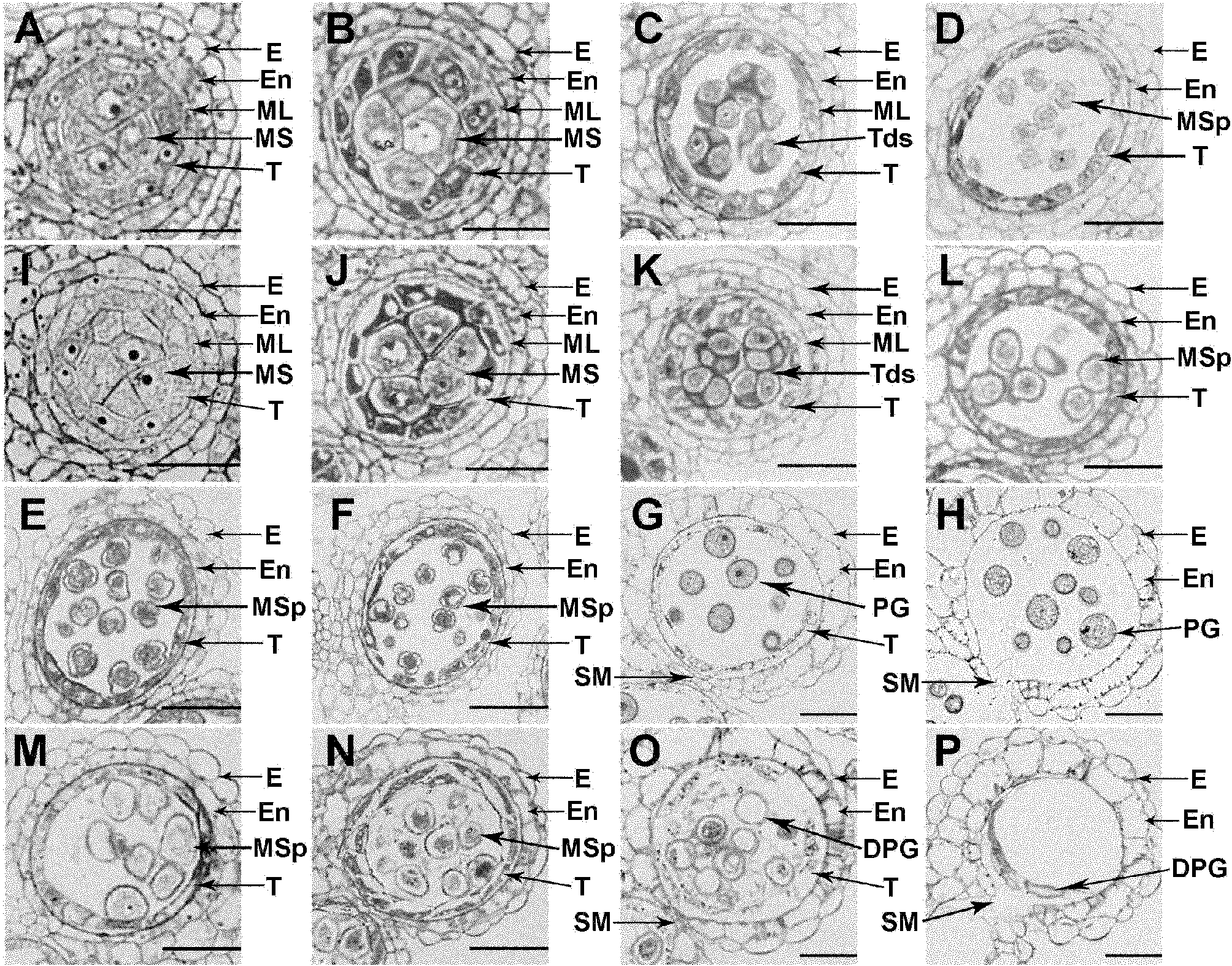Anther development control gene and use thereof in realizing male sterility in Arabidopsis thaliana
An anther and application technology, applied in the field of plant biology, can solve the problems of zero seed setting rate of 100 plants, loss of self-pollination function, pollen abortion and the like
- Summary
- Abstract
- Description
- Claims
- Application Information
AI Technical Summary
Problems solved by technology
Method used
Image
Examples
Embodiment 1
[0062] 1. Arabidopsis thaliana mutant ahl16, the original wild type is Columbia (Col) ecotype (preserved by the Laboratory of Plant Molecular Biology, Shanghai Normal University).
[0063] 2. Arabidopsis material cultivation conditions: Arabidopsis was cultured in black soil; vermiculite; perlite (1:6:0.25) mixed soil after vernalization in 0.1% agarose at 4° C. for 2-4 days. Cover the upper layer with a plastic film to maintain humidity during cultivation, and remove the plastic layer when Arabidopsis germinates cotyledons. The light time is 16 hours of light, 8 hours of darkness, the humidity is kept at 60-70%, the temperature is controlled at 22-25°C, and the light intensity is 50μEm -2 the s -1 , the nutrient solution is PNS (Table 1).
[0064] Table 1. PNS stock composition and 1 L 1×PNS recipe
[0065]
[0066] a: Dissolve 7.45g of Na2-EDTA and 5.57g of FeSO4 in 400mL of water and heat to boil, then mix and continue to boil for 30min, then cool and set the volume t...
Embodiment 2
[0077] Example 2 Cytological observation
[0078] 1. Light microscopy resin sections of plant anthers: get the fresh material of ahl16 mutant and wild type and put it into a penicillin vial equipped with FAA fixative (50% alcohol, 5.0% glacial acetic acid, and 3.7% formaldehyde), pump air and remove it. Seal and store overnight at 4°C. It was subsequently dehydrated through gradient alcohols (50%×2, 60%, 70%, 80%, 90%, 95%, and 100%×2), transferred into xylene, and finally embedded in resin. Slices were then stained with toluidine blue and observed under a microscope. For callose staining, the sections were stained with 0.067M phosphate buffer solution containing 0.05% (w / v) aniline blue, and placed under a UV microscope for observation.
[0079] 2. Production of plant anther materials for electron microscopy: production of scanning electron microscope materials: take fresh anthers and pollen of ahl16 mutant and wild type and fix them on a copper platform with conductive glu...
Embodiment 3
[0081] Example 3 Detection of AHL16 gene expression in anthers by in situ hybridization
[0082] Sampling and embedding: The wild-type and mutant inflorescences were taken with scissors and fixed in FAA. Apply vacuum to infiltrate the fixative into the tissue, and replace the fixative once at 4°C overnight. The fixed material was dehydrated in 50%, 60% and 70% ethanol for one hour each. All the above steps were carried out on ice with gentle shaking from time to time. On the third day, dehydrate in 85% and 95% ethanol at 4°C for 1 hour, then turn to room temperature, dehydrate in 100% ethanol for 2 hours, and then dehydrate in 25% xylene and 75% ethanol, 50% xylene and 50% ethanol. % ethanol mixture, 75% xylene and 25% ethanol mixture (stained with safranin) were placed for half an hour each. Finally the material was placed overnight in 100% xylene containing 1 / 4 volume paraffin wax. On the fourth day the material was placed at 42°C until the wax block was completely melte...
PUM
 Login to View More
Login to View More Abstract
Description
Claims
Application Information
 Login to View More
Login to View More - R&D
- Intellectual Property
- Life Sciences
- Materials
- Tech Scout
- Unparalleled Data Quality
- Higher Quality Content
- 60% Fewer Hallucinations
Browse by: Latest US Patents, China's latest patents, Technical Efficacy Thesaurus, Application Domain, Technology Topic, Popular Technical Reports.
© 2025 PatSnap. All rights reserved.Legal|Privacy policy|Modern Slavery Act Transparency Statement|Sitemap|About US| Contact US: help@patsnap.com



